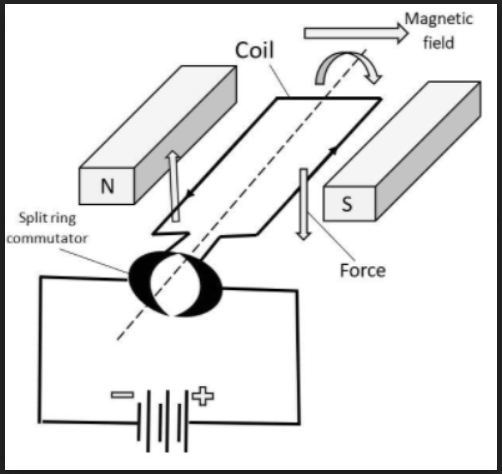
What are the uses of D.C. motor?
Answer
490.8k+ views
Hint: In this question, we can determine the uses of a DC motor on the basis of its principle of working. The main objective of the electric motor is to convert electrical energy into mechanical energy.
Complete step by step solution:
Electric motors work on three different principles of physical sciences. They are- Magnetism, Electro statistics and piezoelectricity.
We can find electrical motors in industrial fans, blowers, pumps, mechanical tools, household appliances, power tools and disk drivers. In above electrical machines, the energy of electromagnetism is converted to the energy of mechanics.
So, the DC motor can be used as below-
We can use small DC motors in tools, toys and home appliances.
We can use large DC motors in propulsion of electric vehicles, elevators and hoists, in the drives of steel rolling mills.
Additional Information:

Above figure shows the diagram of an electric DC motor. According to the diagram, there are following parts of the electric motor.
1. Two magnets (N and S).
2. One loop which is placed between the magnets.
3. Split ring commutator which is attached with the loop.
4. DC power source for power supply.
When the power supply is given to the circuit, there is a magnetic field induced due to the flowing current in the loop. The magnetic field of the two magnets interferes with this induced magnetic field. The loop starts to behave like a magnet. One side of this loop is attracted to the north pole of the magnet and the other side is attracted to the south pole of the magnet. This makes the loop rotate.
Note: We have to remember that the uses of electric motors are determined on the basis of its principle i.e. conversion of electrical energy into mechanical energy. An electric generator and an electric motor are mechanically identical. An electric motor is used to convert electrical energy into mechanical energy whereas an electrical generator is used to convert mechanical energy into electrical energy.
Complete step by step solution:
Electric motors work on three different principles of physical sciences. They are- Magnetism, Electro statistics and piezoelectricity.
We can find electrical motors in industrial fans, blowers, pumps, mechanical tools, household appliances, power tools and disk drivers. In above electrical machines, the energy of electromagnetism is converted to the energy of mechanics.
So, the DC motor can be used as below-
We can use small DC motors in tools, toys and home appliances.
We can use large DC motors in propulsion of electric vehicles, elevators and hoists, in the drives of steel rolling mills.
Additional Information:

Above figure shows the diagram of an electric DC motor. According to the diagram, there are following parts of the electric motor.
1. Two magnets (N and S).
2. One loop which is placed between the magnets.
3. Split ring commutator which is attached with the loop.
4. DC power source for power supply.
When the power supply is given to the circuit, there is a magnetic field induced due to the flowing current in the loop. The magnetic field of the two magnets interferes with this induced magnetic field. The loop starts to behave like a magnet. One side of this loop is attracted to the north pole of the magnet and the other side is attracted to the south pole of the magnet. This makes the loop rotate.
Note: We have to remember that the uses of electric motors are determined on the basis of its principle i.e. conversion of electrical energy into mechanical energy. An electric generator and an electric motor are mechanically identical. An electric motor is used to convert electrical energy into mechanical energy whereas an electrical generator is used to convert mechanical energy into electrical energy.
Recently Updated Pages
Express the following as a fraction and simplify a class 7 maths CBSE

The length and width of a rectangle are in ratio of class 7 maths CBSE

The ratio of the income to the expenditure of a family class 7 maths CBSE

How do you write 025 million in scientific notatio class 7 maths CBSE

How do you convert 295 meters per second to kilometers class 7 maths CBSE

Write the following in Roman numerals 25819 class 7 maths CBSE

Trending doubts
Give 10 examples of unisexual and bisexual flowers

Draw a labelled sketch of the human eye class 12 physics CBSE

Differentiate between homogeneous and heterogeneous class 12 chemistry CBSE

Differentiate between insitu conservation and exsitu class 12 biology CBSE

What are the major means of transport Explain each class 12 social science CBSE

Draw a diagram of a flower and name the parts class 12 biology ICSE




